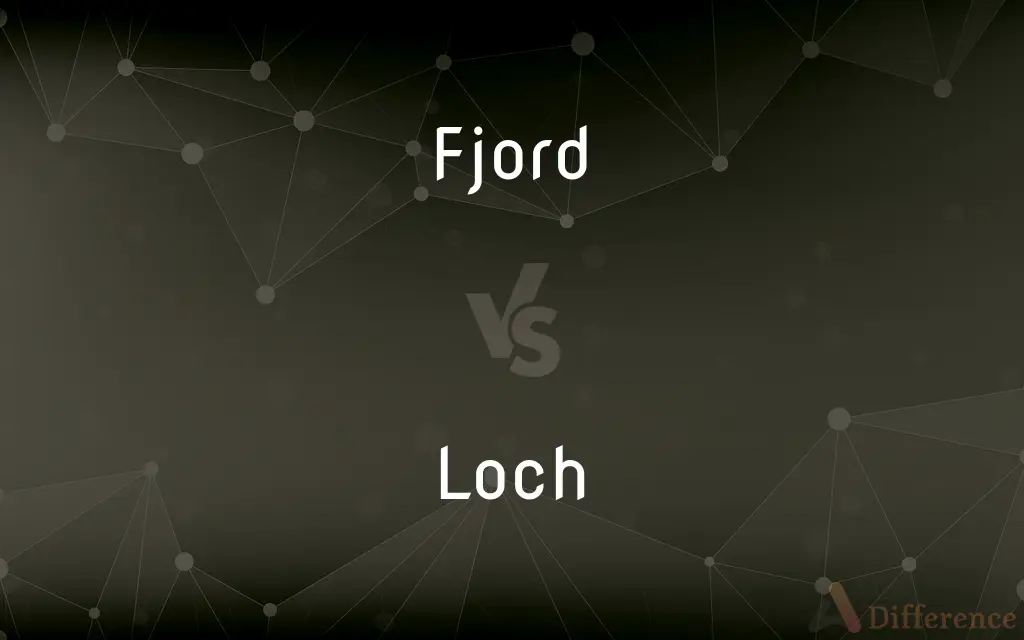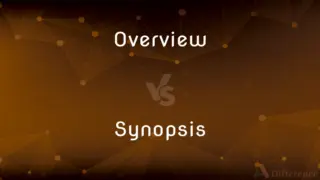Fjord vs. Loch — What's the Difference?
By Fiza Rafique & Maham Liaqat — Updated on April 29, 2024
Fjords are deep, glacially formed inlets characterized by steep cliffs, typically found in Norway, while lochs are Scottish lakes or sea inlets, varying in formation and depth.

Difference Between Fjord and Loch
Table of Contents
ADVERTISEMENT
Key Differences
Fjords are narrow, deep inlets of the sea created by glacial activity, surrounded by steep land on three sides. Whereas lochs, a term used predominantly in Scotland, can refer to both lakes and inlets, formed by various geological processes including glaciation.
The creation of fjords involves the carving by glaciers that then retreat, leaving a U-shaped valley that floods with sea water. On the other hand, lochs might be formed similarly (glacial lochs) or be entirely freshwater bodies formed by other geological activities.
Fjords are typically connected to the sea and have a significant depth, which often makes them ideal for naval navigation. Whereas lochs can be either freshwater or saltwater and their uses vary from being habitats for wildlife to recreational sites.
The surrounding environment of fjords is generally rugged, with high cliffs and minimal human alteration. In contrast, the shores of lochs can be more varied, ranging from rocky precipices to gentle slopes that are often utilized for agricultural or residential purposes.
Fjords are renowned for their dramatic and wild landscapes, often attracting tourists interested in nature and extreme landscapes. Lochs, while also scenic, are integral to Scottish culture and folklore, often featuring in myths and local history.
ADVERTISEMENT
Comparison Chart
Definition
A deep, narrow sea inlet formed by glacial erosion
A Scottish lake or sea inlet, can be freshwater or saltwater
Origin
Glacial activity
Various, including glacial and volcanic activity
Connection to Sea
Typically connected to the sea
May or may not be connected to the sea
Typical Depth
Very deep
Varies, can be shallow or deep
Cultural Significance
Often seen in Norse and broader Scandinavian culture
Central to Scottish culture and folklore
Compare with Definitions
Fjord
A deep valley that is below sea level and filled with seawater after the glacier retreats.
Visitors to the fjords often take boat tours to admire their dramatic beauty.
Loch
Integral to the Scottish landscape, used for fishing, boating, and tourism.
Many lochs are popular destinations for fishing enthusiasts and nature lovers.
Fjord
Popular among tourists for their stunning and remote natural beauty.
Kayaking through fjords can be a breathtaking experience, surrounded by towering cliffs.
Loch
Varies greatly in size and depth, depending on its geological formation.
The depth and size of a loch can greatly influence the types of fish that inhabit it.
Fjord
A long, narrow inlet with steep sides, created by a glacier.
The Geirangerfjord in Norway offers some of the most spectacular fjord scenery available.
Loch
Often the setting for Scottish folklore and historical events.
Historical battles and legends often feature lochs as their backdrop.
Fjord
Characterized by their rugged terrain and extreme depths.
Fjords can be hundreds of meters deep, providing habitats for diverse marine species.
Loch
A Scottish Gaelic term for a lake or a sea inlet.
Loch Ness is famous worldwide due to the mythical monster said to reside in its waters.
Fjord
Primarily found in regions with a history of glaciation, such as Scandinavia.
Fjords are a major feature of the Norwegian coastline.
Loch
Can be freshwater or connected to the sea, known as sea lochs.
Loch Lomond, the largest inland stretch of water in Great Britain by surface area, is a freshwater loch.
Fjord
In geology, a fjord or fiord (alternatively fyord) ( (listen)) is a long, narrow inlet with steep sides or cliffs, created by a glacier. There are many fjords on the coasts of Alaska, Antarctica, British Columbia, Chile, Denmark, Greenland, the Faroe Islands, Iceland, Ireland, Kamchatka, the Kerguelen Islands, New Zealand, Norway, Novaya Zemlya, Labrador, Nunavut, Newfoundland, Quebec, Scotland, South Georgia Island, Isla de los Estados, and Washington state.
Loch
Loch () is the Irish, Scottish Gaelic and Scots word for a lake or for a sea inlet. It is cognate with the Manx lough, Cornish logh, and one of the Welsh words for lake, llwch.
Fjord
A long, narrow, deep inlet of the sea between high cliffs, as in Norway, typically formed by submergence of a glaciated valley.
Loch
A lake.
Fjord
A long, narrow, deep inlet of the sea between steep slopes, especially one shaped by glacial action.
Loch
An arm of the sea similar to a fjord.
Fjord
A long, narrow, deep inlet between cliffs.
Loch
A lake.
Fjord
See Fiord.
Loch
A bay or arm of the sea.
Fjord
A long narrow inlet of the sea between steep cliffs; common in Norway
Loch
Alternative form of lohoch
Loch
A lake; a bay or arm of the sea.
Loch
A kind of medicine to be taken by licking with the tongue; a lambative; a lincture.
Loch
A long narrow inlet of the sea in Scotland (especially when it is nearly landlocked)
Loch
Scottish word for a lake
Common Curiosities
Are fjords found only in Norway?
While fjords are iconic to Norway, they are also found in other countries with glacial history such as Canada, New Zealand, and Chile.
What types of wildlife are commonly found in fjords?
Fjords often host diverse marine life including fish, seals, and sometimes whales, due to their deep and nutrient-rich waters.
Do all lochs have historical or mythical significance?
Many lochs have historical significance or are associated with myths, like Loch Ness with Nessie, though not all have such stories.
Can fjords support commercial navigation?
Yes, their depth and length allow fjords to support commercial shipping routes, making them important for maritime navigation.
What role do fjords play in local economies?
Fjords significantly boost local economies through tourism, fishing, and in some cases, hydropower due to their steep falls and abundant water.
How deep is a typical fjord compared to a typical loch?
Fjords are typically much deeper than lochs, with some fjords reaching depths of over 1,300 meters, whereas lochs vary widely in depth.
How do fjords affect the climate of surrounding areas?
Fjords can affect local climates by channeling and intensifying winds, and their cool waters can moderate temperatures of surrounding areas.
What activities are popular in lochs?
Activities like fishing, boating, swimming, and sometimes monster-hunting in the case of Loch Ness are popular.
How are lochs formed that are not created by glaciation?
Non-glacial lochs can be formed by tectonic activity or by the damming of rivers and streams.
What type of tourism is associated with lochs?
Lochs attract nature lovers, hikers, anglers, and those interested in historical sites and Scottish culture.
Are there any famous historical events associated with lochs?
Yes, several lochs have been sites of historical events, such as Loch Leven, where Mary, Queen of Scots was imprisoned.
Is there a difference in the water quality between fjords and lochs?
Water quality in fjords can be affected by deeper, colder waters and less light penetration, whereas loch water quality varies more based on surrounding land use and water sources.
What is the cultural importance of fjords in Scandinavian countries?
In Scandinavian countries, fjords are central to cultural identity, often featuring in literature, folklore, and art as symbols of natural beauty and resilience.
What geological features distinguish a fjord from a sea loch?
Fjords are characterized by their steep, often rocky sides and deep basins created by glacial movement, whereas sea lochs might be broader and less steep.
Are fjords or lochs more impacted by climate change?
Both are affected by climate change, but fjords may be more sensitive to changes in glacier activity and melting ice, affecting their water levels and marine ecosystems.
Share Your Discovery

Previous Comparison
Involvement vs. Engagement
Next Comparison
Overview vs. SynopsisAuthor Spotlight
Written by
Fiza RafiqueFiza Rafique is a skilled content writer at AskDifference.com, where she meticulously refines and enhances written pieces. Drawing from her vast editorial expertise, Fiza ensures clarity, accuracy, and precision in every article. Passionate about language, she continually seeks to elevate the quality of content for readers worldwide.
Co-written by
Maham Liaqat















































